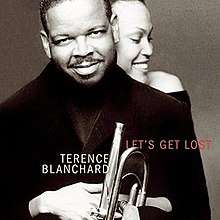Let's Get Lost (album)
| Let's Get Lost | ||||
|---|---|---|---|---|
 | ||||
| Studio album by Terence Blanchard | ||||
| Released | May 22, 2001 | |||
| Recorded | January 16 – February 27, 2001 | |||
| Genre | Jazz | |||
| Length | 1:04:05 | |||
| Label | Sony Classical | |||
| Producer | Terence Blanchard | |||
| Terence Blanchard chronology | ||||
| ||||
| Professional ratings | |
|---|---|
| Review scores | |
| Source | Rating |
| Allmusic | |
Let's Get Lost is a 2001 jazz album by Grammy winning trumpeter Terence Blanchard, with four very well known female vocalists to help him, Diana Krall, Jane Monheit, Dianne Reeves, and Cassandra Wilson.
Recognition
The instrumental track "Lost In a Fog" was nominated for a Grammy in 2001 for "Best Jazz Instrumental Solo,"[2] which showcases what Blanchard is admired for the most—his ability to meld together lush, emotionally evocative melodies.[3]
Critical reception
Ben Ratlif of The New York Times stated "Terence Blanchard's new album, Let's Get Lost, just released by Sony Classics, is an example of jazz marketing at its most finely calibrated. It is a concept album, which is de rigueur if the plan is to sell more than few thousand copies. It is an album of musical-theater songs, which expands the base of jazz-record buyers. It is an underdog-championing album: the songs are by Jimmy McHugh, whom many consider the great overlooked songwriter of prewar show tunes. To sing the songs, it recruits the four most popular jazz singers of the moment: Diana Krall, Cassandra Wilson, Dianne Reeves and Jane Monheit. It's a perfect box of chocolates, not just in marketing but also in music..."[4]
Christopher John Farley of TIME wrote "On this supremely satisfying CD, trumpeter Terence Blanchard, with the help of four jazz divas, pays tribute to the music of songwriting great Jimmy McHugh. Diana Krall whisks in like winter, offering a chilly, elegant take on the title song; newcomer Jane Monheit is spring, with a dewy rendition of Too Young to Go Steady; Dianne Reeves' summery I Can't Believe That You're in Love with Me offers gentle warmth; and Cassandra Wilson's autumnal Sunny Side of the Street is laden with loss but colored with beautiful hues. Blanchard blows his way through these songs with charming, restrained invention..."[5]
A reviewer of All About Jazz mentioned "As a follow-up to his previous album, Wandering Moon, Terence Blanchard has chosen to de-emphasize his compositional skills and to honor the often-overlooked popular songs written by Jimmy McHugh. That would be a fine project for a jazz musician were he or she to reinterpret the tunes, and some of that does occur on Let's Get Lost. However, many of its arrangements are straightforward, perhaps with the underlying addition of bass lines to elevate the tunes, as pianist Edward Simon and bassist Derek Nievergelt do so well on "Let's Get Lost" and "I Can't Give You Anything But Love."[6]
Track listing
| Track | Song Title | Vocals | Composer | Time |
|---|---|---|---|---|
| 1. | Let's Get Lost | Diana Krall | McHugh/Loesser | 5:11 |
| 2. | Too Young to Go Steady | Jane Monheit | McHugh/Adamson | 7:06 |
| 3. | You're a Sweetheart | McHugh/Adamson | 6:44 | |
| 4. | I Can't Believe That You're in Love With Me | Dianne Reeves | McHugh/Gaskill | 5:46 |
| 5. | I'm in the Mood for Love | McHugh/Fields | 5:39 | |
| 6. | Don't Blame Me | Cassandra Wilson | McHugh/Fields | 5:22 |
| 7. | I Can't Give You Anything But Love | Jane Monheit | McHugh/Fields | 5:20 |
| 8. | Exactly Like You | McHugh/Fields | 5:05 | |
| 9. | Can't Get Out of This Mood | Dianne Reeves | McHugh/Loesser | 3:58 |
| 10. | Lost in a Fog | McHugh/Fields | 9:10 | |
| 11. | On the Sunny Side of the Street | Cassandra Wilson | McHugh/Fields | 4:44 |
Personnel
- Terence Blanchard – trumpet
- Diana Krall – vocals, piano
- Jane Monheit – vocals
- Dianne Reeves – vocals
- Cassandra Wilson – vocals
- Brice Winston – tenor saxophone
- Edward Simon – piano
- Derek Nievergelt – bass
- Eric Harland – drums
Charts
| Billboard Chart[7] | ||||
| Year | Category | Weeks on Chart | Peak Position | |
|---|---|---|---|---|
| 2001 | Top Jazz Album | 10 | 3 | |
References
- ↑ Allmusic review
- ↑ Grammy Award search engine
- ↑ Sony Classical review
- ↑ Ben, Ratlif (May 24, 2001). "JAZZ REVIEW; Getting Lost All Over Again, With Singing". The New York Times. nytimes.com. Retrieved 13 November 2017.
- ↑ Farley, Christopher John (May 21, 2001). "Music: Let's Get Lost". TIME. time.com. Retrieved 13 November 2017.
- ↑ "Terence Blanchard: Let's Get Lost". All About Jazz. allaboutjazz.com. 1 July 2001. Retrieved 13 November 2017.
- ↑ Billboard chart history